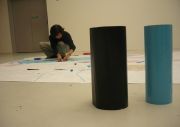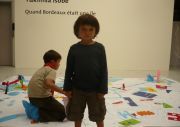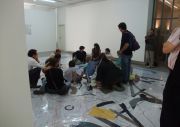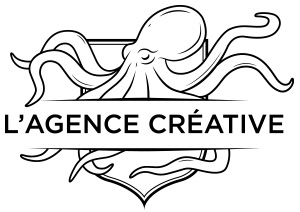
When Bordeaux was an Island/ Quand Bordeaux était une île - Yukihisa Isobe
When Bordeaux was an Island/ Quand Bordeaux était une île
Yukihisa Isobe




Tinbox, DRAC Aquitaine, Arc en Rêve - centre d'architecture, CAPC Musée d'art contemporain de Bordeaux, école des Beaux-Arts de Bordeaux
Tinbox, 16 rue du portail: Opening 18th september 2008 7pm
DRAC, Chapelle des Annonciades: from 20th september to 26 september 2008
Arc en rêve centre d'architecture: From 20th september to 28th 2008
CAPC Musée d'art contemporain de Bordeaux Work shop the 21th of september 2008
École des Beaux-Arts de Bordeaux residency from 1st to 30 august 2008
Yukihisa Isobe—Work That Fuses Art and Environment -
by Naoko Seki, Curator at the Museum of Contemporary Art in Tokyo, Mot
Born in Tokyo in 1935, Yukihisa Isobe studied painting at art University, there after attained prominence in the Tokyo art world as an artist connecting the abstract art of the fifties with early sixties Pop Art methods. Isobe's work was acclaimed by art critic Pierre Restany and also participated in several group exhibitions in Paris, organized by Michel Tapié.
After moving to the United States in 1965, Isobe produced work for events held at New York City parks and islands, at a time when the city unified its culture, park, and recreation departments. As a result of this involvement, his interest shifted from indoor studio work to producing environmental mixed-media art and, eventually, to the ecological environment. After participating in the first Earth Day of 1970, he subsequently entered the University of Pennsylvania and obtained his master of arts in ecological planning. After returning to Japan in 1973, Isobe took part in environmental assessment for the new Kansai International Airport and other such projects as a pioneer in ecological planning in Japan.
At the core of ecological planning is the labor of creating a "natural resource inventory." Wide-ranging ecological data is recorded on transparent overlay maps of the subject region, a composite of such maps then forming the basis for a proposal of the optimal land use method for that region. The natural resource inventory was originally devised so that residents of diverse backgrounds could easily share information about their region's resources in the form of visual images rather than words. In Japan, however, Isobe came to feel that such natural resource inventories were only seen by governmental specialists. From the mid-1990s, he therefore began to visualize natural resources in the form of an artwork, in order to share such information more widely with people in general. Creating such works while living in France in the late '90s, he placed symbols and soil samples on a supporting, thereby enabling a more visceral grasp of natural resource information.
In the 2000s, Isobe has participated in an art triennial held in the mountains of Niigata, Japan. In one work undertaken for that triennial, he planted flags for a distance of 3.5 kilometers along the winding course once followed by the Shinano River, a river now straightened, in order to show the original river course.
His project this time, entitled "When Bordeaux Was an Island" ,attempts to trace and visualize the river courses of the Deveze and Peugue Rivers, which once flowed through the city's heart to the Garonne River, but which today have been filled in and erased from the map. Aided by archeologists resident in Bordeaux, Isobe has created an art work, based on his own fieldwork, that displays primarily ecological information (hydrology, vegetation, land use, wind direction, ocean current, distribution of power lines) on a map of the subject region. The work enables us to envision the process by which Bordeaux has formed and developed as a city, during the past over two thousand years, on an axis of two rivers that are no longer visible today.
Not only from this two-dimensional art work, but also from symbols which will be displayed in the actual city of Bordeaux (2009) and workshops in which participants trace the rivers' courses, we can experience more concretely the city's actions through the centuries, which now lie buried below its historical buildings. Like previous Isobe works, it examines city history from a perspective of vast time and geographic area, and manifests clearly that which has ceased to be visible. This information it applies advantageously, then, toward the city's future. "When Bordeaux Was an Island" is an art project conceived by Isobe as a professional in the two realms of art and environment, based on an entirely original approach to the city of Bordeaux.
[b] Naoko Seki
Yukihisa Isobe is an ecological planner end artist: B.A. from Tokyo National University of art and Music, M.A. from Graduate School of Pensylvania University.
L'artiste et Docteur en sciences de l'environnement, Yukihisa Isobe prépare une exposition d'art contemporain sur l'histoire des rivières de Bordeaux: La Devèze et le Peugue, deux affluents de la Garonne enfouis sous la ville. Son œuvre se présente sous forme de grandes installations au sol sur des plans et cartes de Bordeaux et de la Région Aquitaine. Ce projet à la fois exposition et recherches scientifiques est un travail préparatoire pour une installation in situ, sur les traces de la Devèze et du Peugue, dans les rues de Bordeaux en 2009.
Expositions dans 3 lieux:
Tinbox, 16 rue du portail: Opening 18th september 2008 7pm
DRAC, Chapelle des Annonciades: from 20th september to 26 september 2008
Arc en rêve centre d'architecture: From 20th september to 28th 2008
[b]Conférence:
"Patrimoine et création: autour de l'œuvre de Yukihisa Isobe"
Salle de conférence du Capc musée d'art contemporain de Bordeaux en partenariat avec Arc en rêve centre d'architecture et la DRAC Aquitaine
Dimanche 21 septembre de 16h à 18h
L'artiste japonais Yukihisa Isobe, également docteur en science de l'environnement a fait un travail de recherche sur l'Histoire de Bordeaux à travers ses rivières et notamment de la Devèze et du Peugue deux affluents de la garonne enfouis sous la ville.
Dans le cadre d'une conférence pendant les journées du patrimoine, il présentera ses recherches ainsi que différentes installations réalisées au Japon sur des sites naturels. Chacunes de ses installation est une recherche scientifique sur un site spécifique avec un point de vue rassemblant art, patrimoine, histoire, écologie, géologie...Des spécialistes de l'histoire de Bordeaux animeront également le débat.
Intervenants:
Yukihisa Isobe
Naoko Seki: Commissaire d'exposition au Musée d'art contemporain de Tokyo, Mot
Pierre Régaldo: Archéologue à la DRAC Aquitaine
Anne Guérin: Conservateur du patrimoie à la Mairie de Bordeaux
Architecte
Atelier / workShop avec Yukihisa Isobe:
Pour enfants et familles au Capc musée d'art contemporain de Bordeaux
Samedi 21 septembre 20088 de 15h à 17h
Quand Bordeaux était une île: Sur les traces de la Devèze et du Peugue
Sous les pavées de Bordeaux coulent la Devèze et le Peugue, deux affluents de la Garonne. L'artiste japonais Yukihisa Isobe propose de rendre visible ce patrimoine naturel enfoui sous nos pieds. Cet atelier sera réalisé à partir de cartes anciennes de Bordeaux où paraissent les deux rivières afin de pouvoir imaginer sur des cartes actuelles, avec des collages, comment serait la ville aujourd'hui si ces affluents n'avaient pas disparus.
----------------
La galerie Tinbox présente le travail de Yukihisa Isobe dans le cadre d'une exposition collective pendant les journées Européennes du patrimoine : "Patrimoine et création: L'Annonciade suscite l'imaginaire, une rencontre art et architecture" à la DRAC Aquitaine, rassemblant : Anne-Marie Durou, Tinbox, Michel Herreria, Caroline Molusson et La nouvelle agence.
DRAC Aquitaine: Chapelle et Couvent des Annonciades
54 rue Magendie
33000, Bordeaux
05 57 95 02 02
Ouvert samedi 20 et dimanche 21 septembre pendant les journées du patrimoine et du lundi 22 au vendredi 26 septembre de 9h30 à 12h30 et de 14h à 17h
Photo: Eikichiro Isobe
Cette exposition a reçu le soutient de la DRAC Aquitaine et du conseil Général de la Gironde.
Yukihisa Isobe




Tinbox, DRAC Aquitaine, Arc en Rêve - centre d'architecture, CAPC Musée d'art contemporain de Bordeaux, école des Beaux-Arts de Bordeaux
Tinbox, 16 rue du portail: Opening 18th september 2008 7pm
DRAC, Chapelle des Annonciades: from 20th september to 26 september 2008
Arc en rêve centre d'architecture: From 20th september to 28th 2008
CAPC Musée d'art contemporain de Bordeaux Work shop the 21th of september 2008
École des Beaux-Arts de Bordeaux residency from 1st to 30 august 2008
Yukihisa Isobe—Work That Fuses Art and Environment -
by Naoko Seki, Curator at the Museum of Contemporary Art in Tokyo, Mot
Born in Tokyo in 1935, Yukihisa Isobe studied painting at art University, there after attained prominence in the Tokyo art world as an artist connecting the abstract art of the fifties with early sixties Pop Art methods. Isobe's work was acclaimed by art critic Pierre Restany and also participated in several group exhibitions in Paris, organized by Michel Tapié.
After moving to the United States in 1965, Isobe produced work for events held at New York City parks and islands, at a time when the city unified its culture, park, and recreation departments. As a result of this involvement, his interest shifted from indoor studio work to producing environmental mixed-media art and, eventually, to the ecological environment. After participating in the first Earth Day of 1970, he subsequently entered the University of Pennsylvania and obtained his master of arts in ecological planning. After returning to Japan in 1973, Isobe took part in environmental assessment for the new Kansai International Airport and other such projects as a pioneer in ecological planning in Japan.
At the core of ecological planning is the labor of creating a "natural resource inventory." Wide-ranging ecological data is recorded on transparent overlay maps of the subject region, a composite of such maps then forming the basis for a proposal of the optimal land use method for that region. The natural resource inventory was originally devised so that residents of diverse backgrounds could easily share information about their region's resources in the form of visual images rather than words. In Japan, however, Isobe came to feel that such natural resource inventories were only seen by governmental specialists. From the mid-1990s, he therefore began to visualize natural resources in the form of an artwork, in order to share such information more widely with people in general. Creating such works while living in France in the late '90s, he placed symbols and soil samples on a supporting, thereby enabling a more visceral grasp of natural resource information.
In the 2000s, Isobe has participated in an art triennial held in the mountains of Niigata, Japan. In one work undertaken for that triennial, he planted flags for a distance of 3.5 kilometers along the winding course once followed by the Shinano River, a river now straightened, in order to show the original river course.
His project this time, entitled "When Bordeaux Was an Island" ,attempts to trace and visualize the river courses of the Deveze and Peugue Rivers, which once flowed through the city's heart to the Garonne River, but which today have been filled in and erased from the map. Aided by archeologists resident in Bordeaux, Isobe has created an art work, based on his own fieldwork, that displays primarily ecological information (hydrology, vegetation, land use, wind direction, ocean current, distribution of power lines) on a map of the subject region. The work enables us to envision the process by which Bordeaux has formed and developed as a city, during the past over two thousand years, on an axis of two rivers that are no longer visible today.
Not only from this two-dimensional art work, but also from symbols which will be displayed in the actual city of Bordeaux (2009) and workshops in which participants trace the rivers' courses, we can experience more concretely the city's actions through the centuries, which now lie buried below its historical buildings. Like previous Isobe works, it examines city history from a perspective of vast time and geographic area, and manifests clearly that which has ceased to be visible. This information it applies advantageously, then, toward the city's future. "When Bordeaux Was an Island" is an art project conceived by Isobe as a professional in the two realms of art and environment, based on an entirely original approach to the city of Bordeaux.
[b] Naoko Seki
Yukihisa Isobe is an ecological planner end artist: B.A. from Tokyo National University of art and Music, M.A. from Graduate School of Pensylvania University.
L'artiste et Docteur en sciences de l'environnement, Yukihisa Isobe prépare une exposition d'art contemporain sur l'histoire des rivières de Bordeaux: La Devèze et le Peugue, deux affluents de la Garonne enfouis sous la ville. Son œuvre se présente sous forme de grandes installations au sol sur des plans et cartes de Bordeaux et de la Région Aquitaine. Ce projet à la fois exposition et recherches scientifiques est un travail préparatoire pour une installation in situ, sur les traces de la Devèze et du Peugue, dans les rues de Bordeaux en 2009.
Expositions dans 3 lieux:
Tinbox, 16 rue du portail: Opening 18th september 2008 7pm
DRAC, Chapelle des Annonciades: from 20th september to 26 september 2008
Arc en rêve centre d'architecture: From 20th september to 28th 2008
[b]Conférence:
"Patrimoine et création: autour de l'œuvre de Yukihisa Isobe"
Salle de conférence du Capc musée d'art contemporain de Bordeaux en partenariat avec Arc en rêve centre d'architecture et la DRAC Aquitaine
Dimanche 21 septembre de 16h à 18h
L'artiste japonais Yukihisa Isobe, également docteur en science de l'environnement a fait un travail de recherche sur l'Histoire de Bordeaux à travers ses rivières et notamment de la Devèze et du Peugue deux affluents de la garonne enfouis sous la ville.
Dans le cadre d'une conférence pendant les journées du patrimoine, il présentera ses recherches ainsi que différentes installations réalisées au Japon sur des sites naturels. Chacunes de ses installation est une recherche scientifique sur un site spécifique avec un point de vue rassemblant art, patrimoine, histoire, écologie, géologie...Des spécialistes de l'histoire de Bordeaux animeront également le débat.
Intervenants:
Yukihisa Isobe
Naoko Seki: Commissaire d'exposition au Musée d'art contemporain de Tokyo, Mot
Pierre Régaldo: Archéologue à la DRAC Aquitaine
Anne Guérin: Conservateur du patrimoie à la Mairie de Bordeaux
Architecte
Atelier / workShop avec Yukihisa Isobe:
Pour enfants et familles au Capc musée d'art contemporain de Bordeaux
Samedi 21 septembre 20088 de 15h à 17h
Quand Bordeaux était une île: Sur les traces de la Devèze et du Peugue
Sous les pavées de Bordeaux coulent la Devèze et le Peugue, deux affluents de la Garonne. L'artiste japonais Yukihisa Isobe propose de rendre visible ce patrimoine naturel enfoui sous nos pieds. Cet atelier sera réalisé à partir de cartes anciennes de Bordeaux où paraissent les deux rivières afin de pouvoir imaginer sur des cartes actuelles, avec des collages, comment serait la ville aujourd'hui si ces affluents n'avaient pas disparus.
----------------
La galerie Tinbox présente le travail de Yukihisa Isobe dans le cadre d'une exposition collective pendant les journées Européennes du patrimoine : "Patrimoine et création: L'Annonciade suscite l'imaginaire, une rencontre art et architecture" à la DRAC Aquitaine, rassemblant : Anne-Marie Durou, Tinbox, Michel Herreria, Caroline Molusson et La nouvelle agence.
DRAC Aquitaine: Chapelle et Couvent des Annonciades
54 rue Magendie
33000, Bordeaux
05 57 95 02 02
Ouvert samedi 20 et dimanche 21 septembre pendant les journées du patrimoine et du lundi 22 au vendredi 26 septembre de 9h30 à 12h30 et de 14h à 17h
Photo: Eikichiro Isobe
Cette exposition a reçu le soutient de la DRAC Aquitaine et du conseil Général de la Gironde.


